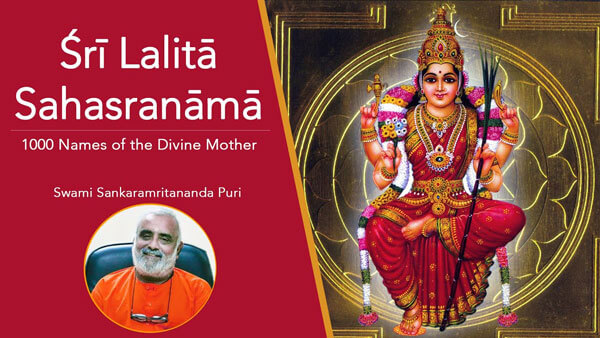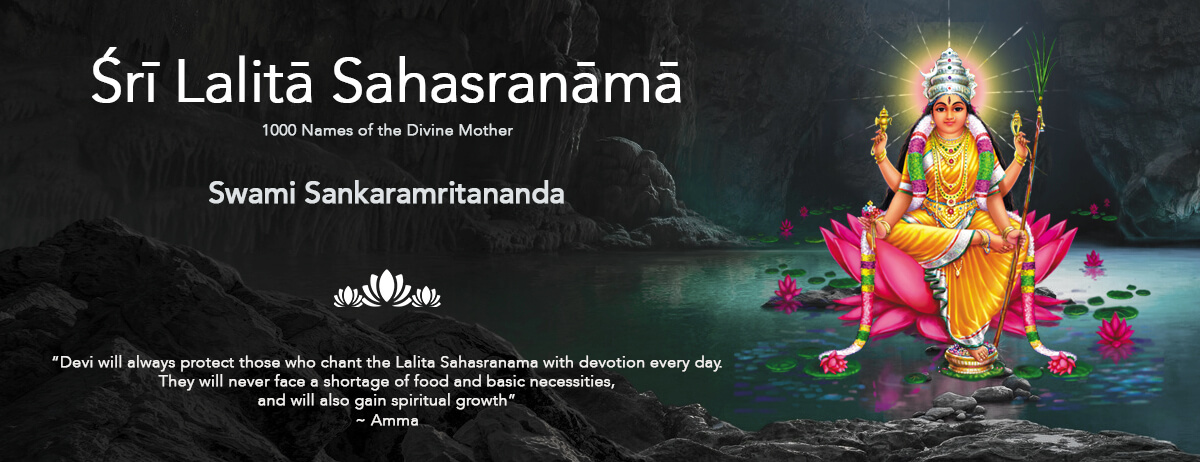Swami Sankaramritananda Puri is a monastic disciple of Amma, Satguru Sri Mata Amritanandamayi Devi. A Sanskrit scholar and an Ayurveda doctor by profession, Swami heads the School of Ayurveda of the Amrita University.

He is explaining the mantras and meanings is a very simple lucid conveying the profound wisdom of this land. These episodes have been aired on AmritaTV long back. We are presenting them for the devotees and seekers to enjoy and realise.
Read what Amma says about Lalita Sahasra Nama.
- ഹ്രീം – ബീജാക്ഷരം (ലളിതാ ത്രിശതി 292-294) Hrīm – The Sacred Syllable (Lalita Trishati)There are sixty mantras in Lalitha Trishathi that began with the word Hrim.The next mantra is Om hrīṁkāra bōdhitāyai namaḥ(… who is Hrim and Hrim is She.) It means she who is known by the sound Hrim. We cannot separate word and meaning. When we hear a word, we right away relate it to the… Read more: ഹ്രീം – ബീജാക്ഷരം (ലളിതാ ത്രിശതി 292-294) Hrīm – The Sacred Syllable (Lalita Trishati)
- ഹ്രീം – ബീജാക്ഷരം (ലളിതാ ത്രിശതി 289-290) Hrīm – The Sacred Syllable (Lalita Trishati)Om hrīṁkāra kōśāsilatāyai namaḥ is the next mantra(… who is the shining sword in the sheath called Hrim) Om hrīṁkārāsthāna nar-ttakyai namaḥ is the following mantra(… who is the dancer on the stage called Hrim) Usually, a sword kills bad people, our enemies, and thus protects the good and our dear ones. This mantra means… Read more: ഹ്രീം – ബീജാക്ഷരം (ലളിതാ ത്രിശതി 289-290) Hrīm – The Sacred Syllable (Lalita Trishati)
- ഹ്രീം – ബീജാക്ഷരം (ലളിതാ ത്രിശതി 283-286) Hrīm – The Sacred Syllable (Lalita Trishati)The next mantra is“Om hrīṁkāra dugdhābdhi sudhāyai namaḥ”(Devi who is the ambrosial nectar in the ocean of milk called Hrim) Dugdham means milk. Abdhi means ocean. Sudha means – Ambrosia. Devi is the ambrosial nectar in the ocean of milk. We all know the popular legend of the churning of the ocean of milk. There… Read more: ഹ്രീം – ബീജാക്ഷരം (ലളിതാ ത്രിശതി 283-286) Hrīm – The Sacred Syllable (Lalita Trishati)
- ഹ്രീം – ബീജാക്ഷരം (ലളിതാ ത്രിശതി 219,220,281,282) Hrīm – The Sacred Syllable (Lalita Trishati)We are listening to the commentary on the mantra “Om hrīmkāryai namaḥ” in the Lalitha Sahasranama. This mantra is explained in greater detail, as sixty mantras, in the Lalitha Trishathi. We are looking into the interpretation of those sixty mantras. The Lalitha Trishati is commonly chanted all over Kerala. The next two mantras areOm hrīṁkārasumanōmādhvyai… Read more: ഹ്രീം – ബീജാക്ഷരം (ലളിതാ ത്രിശതി 219,220,281,282) Hrīm – The Sacred Syllable (Lalita Trishati)
- ഹ്രീം – ബീജാക്ഷരം (ലളിതാ ത്രിശതി 217 – 218) Hrīm – The Sacred Syllable (Lalita Trishati)A possible explanation for the mantra hrīṁkārakandarā siṁhi can be as follows, There is a cave on top of a mountain. Devi is the lioness whose den is the cave.
- ഹ്രീം – ബീജാക്ഷരം (ലളിതാ ത്രിശതി 209 – 214) Hrīm – The Sacred Syllable (209 to 214 in Lalita Trishati.)We are listening to the commentary of the mantra Om hrīmkāryai namaḥ (who is in the form of the syllable hrim.) in the Lalita Sahasranama.
- ഹ്രീം – ബീജാക്ഷരം (ലളിതാ ത്രിശതി 205 – 208) Hrīm – The Sacred Syllable (205 to 208 in Lalita Trishati.)We were discussing the connected mantras in Lalita Trisati related to hrīṅ kāryai namaḥ
- ഹ്രീം – ബീജാക്ഷരം (ലളിതാ ത്രിശതി 201- 204) Hrīm – The Sacred Syllable (201 to 204 in Lalita Trishati.)In Lalita Trisati, the syllable hrim is used in 60 different ways. Now we will see the mantras 200-220 from Lalita Trisati.
- ഹ്രീം എന്ന ബീജാക്ഷരം (ലളിതാ ത്രിശതി 80- 100) The Sacred Syllable Hrīm (80 to 100 in Lalita Trishati.)Hrim is the 5th seed syllable of the Pancha Dashakshari mantra (mantra with 15 syllables).
- ഹ്രീം എന്ന ബീജാക്ഷരം – The Sacred syllable HrīmFor a spiritual practitioner material possessions are not important. His wealth is his mantra.
- നാദരൂപാ നാമരൂപ വിവർജ്ജിതാ – Devi as Form of Sound and FormlessThe scriptural sciences say that there are five aspects to the Universe. They are Asthi, Bhaathi, Priyam, Naamam, Roopam.
- നാദരൂപയായ ദേവി – The origin of the sound is DeviThe four forms of sound are classified as parā, paśyanti, madhyamā, and vaikharī.
- ദേവിയുടെ പാദധൂളി – Dust of Devi’s FeetCreation, Maintenance, and Destruction are three of the divine attributes of the divine dust from the lotus feet of Devi.
- പുണ്യാപുണ്യ ഫലപ്രദാ – Devi Dispenses Fruits of ActionsWhen life is lived in obedience to Vedic dharma, happiness is gained. It leads to punya (merit gained by good deeds).
- ദേവിയുടെ ആജ്ഞയാണ് വേദങ്ങൾ – Vedas are Divine Mother’s commands.The Divine mother wants to follow the instructions in the Vedas. That is the command of the Divine Mother.
- ആയിരം പാദങ്ങളുള്ളവൾ – One who has a thousand feet.A ‘thousand’ denotes the infinite nature of the lord. It does not mean just one thousand. It means that the earth is filled with, replete with the presence of God.
- ആബ്രഹ്മകീടജനനീ – Divine Mother is the mother of alleverybody must evolve in life performing their duties well. Everybody has a right to God-realization. She takes effort for uplifting all beings.
- വർണ്ണാശ്രമ വിധായിനി – The One who establishes VarṇāśramaThe four age-based life stages are Brahmacharya (Students), Grihastha (Householder) Vanaprastha (retired) Sanyasa (renunciation). Then we have the Athivarna (Who are beyond the four Varnas).
- സൃഷ്ടി ദൃഷ്ടി വാദം – Creation and Dissolution of the UniverseWhen Devi opens her eyes, the universe is created, and when She closes Her eyes the world dissolves. In Vedanta, it is called “Shrishti Drishti Vaadam”. The universe is within us.
- അവസ്ഥാത്രയ സാക്ഷി – Devi is the witness to the three statesThe Pure Self is the witness to the Jagrat, Swapna, and Sushupti states.
